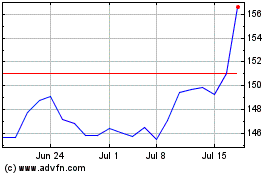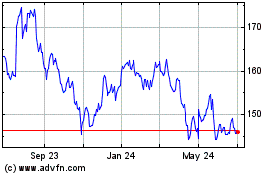By Peter Loftus
Johnson & Johnson rushed to test its famous baby powder last
month after the U.S. Food and Drug Administration found asbestos in
a bottle and triggered a recall. The company announced 11 days
later that independent testing had found no trace of the
contaminant.
But J&J's push for a rapid turnaround contributed to results
that were more complicated, a review of lab reports released by the
company shows.
A Pennsylvania lab hired by J&J deviated from its normal
process to meet J&J's timetable, adding a testing room normally
used to analyze gunshot residue in crime investigations, according
to letters J&J received from the testing company and released.
Initially, the lab found trace amounts of asbestos in some samples
of Johnson's Baby Powder but later determined that the second room
was contaminated by an air-conditioning unit, according to the
letters. Repeat tests in the lab's normal testing room found no
asbestos.
A second lab that J&J hired, in Georgia, told the company
its preliminary testing found no asbestos. It hadn't completed its
tests when J&J announced on Oct. 29 that no traces of asbestos
were found, a letter from that lab shows.
J&J said it is continuing to investigate, including with
ongoing sample testing, and will provide an update in due
course.
J&J's rapid response challenging the FDA's findings reflects
how important Johnson's Baby Powder is to the New Brunswick, N.J.,
health-care conglomerate. Baby powder generates less than 1% of
total sales, but because the product is so well-known, the FDA's
asbestos finding represents a threat to J&J's reputation for
quality.
At the same time, J&J is defending lawsuits from nearly
100,000 plaintiffs over product safety and marketing, including
16,000 suits claiming its powder caused ovarian cancer in women who
used it for feminine hygiene, and a rare cancer known as
mesothelioma in people who inhaled it. J&J says its talcum
powder is safe, asbestos-free and doesn't cause cancer.
Plaintiffs' lawyers have sent the FDA's powder findings to a
federal judge, who is expected to decide in coming weeks whether
there is enough evidence for a majority of the lawsuits to
proceed.
"Given the serious questions raised by the FDA's test results,
our investigation of course started and moved with speed and
diligence," J&J said in a statement. "We asked the labs to work
as quickly as possible to retest those samples so we could better
understand what FDA reported."
This account is based on a review of lab reports and letters
released by both the FDA and J&J, court documents in the talc
litigation and interviews with people involved in the testing and
with independent testing experts.
Talc -- the basis of talcum powder -- and asbestos are naturally
occurring minerals that can be found near each other in the earth.
The FDA says talc can be contaminated by asbestos if mines aren't
selected carefully and talc isn't sufficiently purified. Asbestos
was widely used in construction but is now known to cause
cancer.
Last year, in response to reports of cosmetics containing
asbestos, the FDA started a round of product tests, contracting
with AMA Analytical Services Inc., in Lanham, Md., for many.
In early September, the AMA lab analyzed a bottle of Johnson's
Baby Powder provided by FDA. It used an optical microscope and a
microscope that beams electrons to generate images with higher
resolution but in smaller sample sizes.
AMA analyzed three subsamples, each a fraction of one 22-ounce
bottle. The electron microscope detected asbestos in two
subsamples, in amounts well under 0.1% by weight, and didn't detect
it in the third. The optical-microscope analysis didn't detect
asbestos in any of the subsamples.
AMA provided a report of results to the FDA dated Oct. 11.
J&J said it received the report from FDA Oct. 17 and announced
the next day it would voluntarily recall 33,000 bottles of powder
from the same lot.
At J&J's request, the FDA retrieved the remainder of the
positive sample bottle from AMA and provided it to J&J, which
in turn provided it to a Monroeville, Pa., lab-testing firm, RJ Lee
Group.
J&J also flew a separate sample of powder from the recalled
lot and bags of milled talc that hadn't yet been made into a
finished product to the Pittsburgh airport, where an RJ Lee
employee picked them up, according to an Oct. 28 letter from the
firm, which J&J posted online
J&J didn't set a deadline but wanted "some very rapid
turnaround for obvious reasons," Drew Van Orden, senior consulting
scientist at RJ Lee Group, said in an interview. To prepare samples
simultaneously, workers moved some of them from the standard
preparation room to the room normally used for gunshot-residue
testing "in order to meet the deliverable timeline," the RJ Lee
letter said.
Using electron microscopes, RJ Lee technicians found traces of
asbestos in some samples from the recalled lot and the milled talc
that had been prepared in the second room. In contrast, samples
prepared in the standard room tested negative, leading workers to
suspect the second room was contaminated.
The second room was warm, and workers had brought in an
air-conditioning unit. Lab workers investigated and found traces of
asbestos in the air-conditioning unit. RJ Lee concluded that some
samples had been contaminated by the environment.
The lab repeated testing on the recalled lot, this time
preparing samples in the standard room, and didn't detect
asbestos.
In Oct. 28 letters to J&J, RJ Lee said that in samples from
the bottle tested by the FDA and from the same lot, "no asbestos
contamination was found."
Mr. Van Orden said he read the report provided to the FDA from
the Maryland firm and couldn't explain the different results. AMA's
technical director, Andreas Saldivar declined to comment and
referred questions to the FDA.
The FDA, in a statement, said the distribution of contaminants
in a powder might not be uniform. It also said testing of different
samples, even from the same bottle, could yield different
results.
Frank Ehrenfeld, lab director of International Asbestos Testing
Laboratories in Mount Laurel, N.J., who wasn't involved in the
powder testing, said it is difficult to come to a conclusion about
whether J&J's baby powder contains asbestos, because the
FDA-hired lab found a small amount and the finding hasn't been
replicated.
"You need more at-bats to really determine what the batting
average is for this sample," he said.
J&J also sent samples to another lab, Bureau Veritas North
American Inc., in Kennesaw, Ga. That lab sent a letter to J&J
on Oct. 27 saying no asbestos was detected in some of the samples
using electron-microscopy. The letter said testing was still under
way and additional results were expected.
J&J announced that its baby powder tested asbestos-free on
Oct. 29. The company said it released results because it had enough
tests on the single bottle to have "full confidence it did not
contain asbestos."
Bureau Veritas's director didn't respond to requests for
comment.
Write to Peter Loftus at peter.loftus@wsj.com
(END) Dow Jones Newswires
November 17, 2019 05:44 ET (10:44 GMT)
Copyright (c) 2019 Dow Jones & Company, Inc.
Johnson and Johnson (NYSE:JNJ)
Historical Stock Chart
From Mar 2024 to Apr 2024

Johnson and Johnson (NYSE:JNJ)
Historical Stock Chart
From Apr 2023 to Apr 2024
